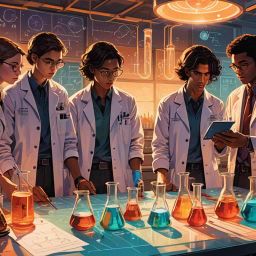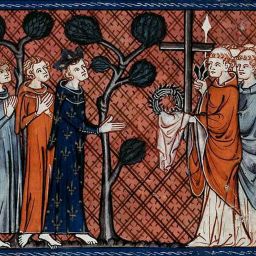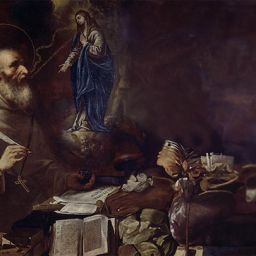
About the Author
Tomi Sawyer, PhD. SAGI Founding President & Chief Torchbearer
Words of Wisdom: As a child, I dreamed of being Superman. As a teenager, I strove to be an intellectual force like Spock from Star Trek. During these years, my faith in God was kindled. Studying the natural biological sciences provides a phenomenal opportunity to realize God as the Inimitable Designer of Life. In this article, I share a few thoughts on my odyssey and reflections upon virtuous science, inspiring faith, and seeking wisdom. May our Lord’s words, “You will know the Truth, and the Truth shall set you free.” (John 8:32) encourage us to become scholars, scientists, and SAGI Torchbearers seeking knowledge, reverence, and truth.
I grew up in a small town named Greenbush, in rural northern Minnesota after my parents sought a good place to live after World War II ended. My grandfather, Albert, invited them to reside with him on his 40-acre retirement farm. He had cattle, sheep, and chickens, and there were always plenty of daily chores. Fortunately, I had the opportunity to learn many things from my grandfather, as the day he passed away marked the beginning of new responsibilities for me as a young farm kid. Nevertheless, being outdoors and exploring what seemed like a vast wilderness around our home coupled well with a strong imagination to escape the daily routine.
During these early years my parents allowed me to buy comic books, and my all-time favorite was Superman. I was fascinated by this superhero. I often had dreams of flying and having his powers and fearlessness. I still remember those vivid dreams of flying, feeling the wind on my face as I cruised through the skies. Yet, my days of being like Superman would soon be surpassed by my first spiritual encounter with God, and this would become a profound recollection for me.
As a newbie teenager, I was mesmerized by the television series Star Trek, and I imagined being on the Starship Enterprise to “Boldly go where no man has gone before!” Spock was the super-scientific character who had profound knowledge with undaunted logic that was seemingly invincible. I wished to be like Spock, which meant taking my education to a new level. This was the start of my own trek to become a scholar. Chemistry, biology, and physics were especially intriguing to me during my high school years, and I further pursued these scientific disciplines throughout my undergraduate studies at Minnesota State University Moorhead and graduate studies at the University of Arizona, ultimately earning a doctorate degree. Although at times this was an exhausting scholarly marathon, it was a pivotal part of my odyssey.
I was blessed to have an extraordinary experience in my graduate studies at the University of Arizona. Significant credit goes to being co-mentored by two very gifted academic scientists who were each on their paths to being world renowned for their contributions in chemistry and biology. They encouraged the collective research team to deeply think about the science being explored. This multidisciplinary collaboration focused on α-melanocyte
stimulating hormone (α-MSH, a peptide involved with pigmentation) and was appropriately dubbed the “α-MSH Project.” Our work evolved in remarkable ways, including a breakthrough medicine for those afflicted with erythropoietic protoporphyria (EPP). In retrospect, the chemical synthesis of peptides was emerging quickly from 1970-1980, and it was an exciting time in both academia and industry (biotech and pharma) to create peptide drugs for many different therapeutic indications. In my first series of α-MSH analogs, NDP-MSH(1) was designed, synthesized, tested, and became a worldwide research tool, as well as an FDA approved drug, for the treatment of EPP and other skin pigmentary diseases. In fact, a documentary(2) entitled “Out of the Shadows” was shown by NBC Dateline in June 2015 to bring attention to
children suffering with EPP and to educate the audience about NDP-MSH (aka Afamelanotide or Scenesse® by Clinuvel)(3). In a second series of α-MSH analogs, cyclic-MSH(4) was designed, synthesized, tested, and propelled our University of Arizona team into worldwide fame by successfully transforming a linear peptide (α-MSH) into a cyclic peptide (cyclic-MSH) with
strong physiological activity (a super agonist). This discovery provided a conceptual framework to show how a peptide interacts with its cellular receptors (for α-MSH it was the melanocortin-1 receptor [MC1R]). Amazingly, forty years later, the first high-resolution 3D structures(5,6) of α-MSH, afamelanotide, and Setmelanotide (an analog of the original cyclic-MSH) would confirm our conceptualizations of the 3-D binding of α-MSH and cyclic MSH super agonist to the MC1R. I have recently reflected upon this story in a special tribute(7) to Professor Victor Hruby and both past and current MSH Project Team members. I now see this first chapter of my odyssey as a gift from God. I was guided to a scholarly oasis where I did face many obstacles, but ultimately shared with my colleagues a great triumph in science.
In late 1981, I took my first steps as a professional, industry scientist to join the fledgling Biotechnology Division of the Upjohn Company (Kalamazoo, Michigan). There also, my life became more balanced with marriage and fatherhood (of two sons). I converted to Catholicism and contemplated on the spirituality of being a drug discovery scientist. I was engaged in several major R&D campaigns including the first Science publication(8) of a
synthetic HIV protease inhibitor (U-81749) that was also announced by Tom Brokaw (NBC Nightly News) in 1990 as a major drug for the treatment of HIV. This was a first among many reports on HIV protease inhibitors from both pharma and biotech companies worldwide in what evolved into a race to the clinic and development of FDA-approved HIV drugs.
In mid 1991, I accepted my first management position at Parke-Davis Pharmaceutical Research (Ann Arbor, Michigan) and a concurrent appointment as an adjunct professor of medicinal chemistry at the University of Michigan. I had a talented team of computational and synthetic chemists who discovered novel, peptidomimetics(9,10) as breakthrough inhibitors
of HIV protease and Src homology-2 domains (an emerging class of intracellular targets involved in signal transduction). It was during this time that my wife, sons, and my father (who was 79 years old at the time) were able to listen to me speak as a Parke-Davis Distinguished Lecturer by the invitation of Pedro Cuatrecasas, President of the Pharmaceutical Research
Division. It was a very special honor to share this with both my family and scientist friends.
In late 1997, I accepted a position of Director of Drug Discovery, at Ariad Pharma (a biotech that was acquired by Takeda Pharma a few years ago). I was initially hesitant to move from large pharma to a biotech that was <1% the size, however I quickly learned that I joined a team of highly skilled, motivated, and scholarly individuals wanting to succeed in drug discovery. Among them, we had outstanding synthetic chemists, computational chemists, structural biologists, and pharmacologists. We achieved a series of drug discovery breakthroughs(11-14) on key intracellular targets, including Src kinase for osteoporosis and Bcr-Ablkinase for chronic myelogenous leukemia (CML). In the latter case, the first inhibitor of all-clinical-mutant versions of Bcr-Abl kinase, AP24543 (ponatinib, Iclusig®) was discovered and was FDA-approved for CML therapy. Our work also evolved synthetic chemistry for specific phosphorus moieties as key design features for two FDA-approved drugs, Ridaforolimus (EluNIR® Ridaforolimu Eluting Coronary Stent System) and Brigatinib (Alunbrig®). In retrospect, Ariad Pharma was my most successful adventure in drug discovery in terms of novel design, chemistry, and producing three FDA-approved, marketed drugs. During my time at Ariad Pharma, I was promoted (Vice-President and then Senior Vice-President of Drug Discovery) by management, as were my colleagues, in recognition for our accomplishments.
In late 2007, I accepted a position as Chief Scientific Officer at a start-up biotech, Aileron Therapeutics, as one of the first employees. This was a unique experience for me in terms of building a team from scratch, establishing research operations, brainstorming science and technology platforms, and engaging corporate and business development along with the rest of the leadership team. Most of this experience was fun and exciting as we created a first-time R&D platform to advance a new scaffold of macrocyclic,α-helical peptides for several therapeutic targets, especially intracellular transcription factor for cancer pathogenesis. Of these, the design of novel modulators of oncogene p53 was our greatest achievement and
this included both a key preclinical lead molecule (ATSP-7041)(15) and a clinical candidate, Sulanemadlin (ALRN-6924),(16) which was the first-in-class for this macrocyclic peptide modality. Amazingly, the timing for the early days of Aileron Therapeutics was besieged by the economic doom and gloom of the so-called Great Recession (the most severe financial crisis since the Great Depression) of 2007-2008 in America. However, Aileron Therapeutics provided one of the very first big wins for biotech in 2010 as the result of a $1.1B deal with Roche Pharma to leverage its technology platform for key therapeutic targets, including the p53 project. This collaboration benefitted from the expertise of the Roche scientists who were world leaders in
p53 targeted drug discovery. As ALRN-6924 advanced to become a clinical candidate, a decision was made in 2013 to focus on drug development and an initial public offering (IPO). Indeed, in 2017 Aileron was listed on the NASDAQ (ticker symbol “ALRN”).
In mid 2014, I began my last drug discovery campaign experience within my “classic” pharma/biotech career by accepting an offer from Merck as a Distinguished Scientist and a 5-year mission to rebuild its peptide drug discovery platforms and pipeline. Although this seemed a daunting task, I was quite enthusiastic to do it. I established the Merck Peptide Drug Hunter
Network of more than 100 multidisciplinary scientists as well as many internal and external working relationships. Two key collaborations were with PeptiDream (Japan) and A*STAR (Singapore), and they greatly supported Merck’s intracellularly targeted peptide drug discovery. This work included a basic science and technology effort on p53 to exploit the milestone accomplishments of Aileron Therapeutics to advance a deeper-dive into the
design, chemistry, biology, cell permeability, and metabolic stability of macrocyclic a-helical peptides. Overall, this was my most successful adventure in drug discovery as a pharma scientist, and it also included many top tier scientific publications.(17-22)
On my last day at Merck, which was also my 65th birthday, I reflected upon my career in drug discovery as well as “retirement” plans with my Merck friends. In retrospect, it was intriguing that my first professional scientist job offer was from Merck (1981), and thirty-three years later (2014) I would join the Merck global R&D scientific team. My future goals included:
(i) for my family, to establish a scientific consulting/advisory business “Maestro Therapeutics”; (ii) for my friends, to establish a global peptide drug hunter network “Peptide Drug Hunting Consortium”; and (iii) for my faith, to establish the “Saint Albert the Great Institute (SAGI) for Science, Faith & Wisdom”. These were inspirational goals for me to launch a new 5-year
mission to be a multidisciplinary entrepreneur via Maestro Therapeutics, and then to pursue launching the Peptide Drug Hunting Consortium and the Saint Albert the Great Institute for Science, Faith & Wisdom.
This year will mark the 5th anniversary since I founded Maestro Therapeutics. Its inaugural mission was empowering drug discovery to support the cause for early- and mid-staged biotechs relative to their drug discovery platforms and R&D pipelines to advance compelling peptide therapeutic modalities into the clinic. Overall, Maestro Therapeutics has contributed by both scientific R&D consulting and advocating financial investment (venture capital) or R&D partnering (pharma) for many biotechs in its business portfolio. Over the last two years, Maestro Therapeutics has engaged my two sons who have each recently achieved their Ph.D. degrees in chemistry/biochemistry and cellular/molecular biology. Together, we are multidisciplinary entrepreneurs who are supporting the development of peptide therapeutic modalities that may ultimately become breakthrough medicines for those who suffer with life-threatening and/or debilitating disease. Recently, and with many outstanding entrepreneurs from academia, biotech, pharma, investors, contract R&D organizations and service providers, I’ve launched the Peptide Drug Hunting Consortium. It is with hope of exploiting our collective talents that we may fortify the science/business interface of peptide drug discovery and future breakthrough medicines.
One point I wish to share is that from a chemistry and biology perspective, molecules may be designed and synthesized for a specific target (e.g., receptor, enzyme) to modulate its function, but they often have unexpected negative effects (generally referred to as ‘off-target’ and ‘toxic’). This is part of the challenge of drug discovery, and those molecules which have toxicity are generally eliminated from further development, albeit they are still important to guide the optimization of the class (or series) of molecules from which they may be chemically/structurally related. While drug discovery is challenging and typically requires a great deal of time and money, it is very rewarding to match a new medicine to an unmet need, especially for all those engaged in the multidisciplinary scientific effort.
These days, knowledge is abounding for those pursuing virtuous science, especially in technology and medicine. One must strive to be scholarly and be intellectually driven to review the scientific literature and understand the purpose, methods, and shared learnings from such work. Beyond this knowledge, one must strive for reverence and truth as it relates to
the science of life. In fact, all scientific inquiry that permeates the biology of life should adopt principles of bioethics and seek virtue for the common good as well as embracing theological and philosophical discernment. Life is precious, and the pursuit of virtuous science is both propitious and daunting. Yet, many other things in the history of humanity have been very challenging, but the focus must remain on what is good for the glory of God. Indeed, this is yet a great intention for ardent prayers and genuine desire to do good work in all aspects of life.
Contrary to those who may surmise that all scientists are indifferent to believing in God, this notion is neither realistic nor logical. Many scientists representing various disciplines throughout history lived as devout believers in God, including Saint Albert the Great.(23-33) Most importantly, there isn’t any scientific evidence or experimental works that demonstrate the creation of life, even in its simplest living form, from inanimate materials. This remains true even considering that our current technologies include the most sophisticated chemical reagents and research laboratories, surpassing the volatile conditions of primordial Earth. I am not saying the creation
of life is impossible, but rather that the creation of life is only possible by a Being of Inimitable attributes and qualities (e.g., infinite, omnipotent, immutable, omnipresent, perfect), a Designer of Life, namely God. In what sense is God inimitable? Only God can create organisms and sustain their life principles ex nihilo (out of nothing), whereas human beings can only make things (from pre-existing materials). “Inimitable Designer” refers, in glorifying acknowledgement, to God as the Greatest Scientist.
For scientists, I hope this is a humble testimony and revelation to reflect on God’s power in the creation of life. Furthermore, this is an opportunity for all who share in faith to behold God the Creator with love and gratitude. Indubitably, I now appreciate more the intricacies of life from a scientific perspective and how extraordinarily complex life is. Specifically, I’m referring
to how highly-orchestrated the engine of life is, especially considering the integration of all the underlying chemistry, biology, and physics. Not only are its constituents (e.g., nucleic acids, proteins, lipids, carbohydrates, water, and other organic and inorganic molecules) complex, but also the exquisite specificity of biological processes in spatial and temporal ways. Furthermore, we know that life exemplifies such properties in replication and development.
Importantly, please know that my thoughts here are not a revelation from of my being a scientist; rather, being a scientist has affirmed my faith in the Inimitable Designer of Life, and the mystery of the Creation of Life.
My odyssey has been at the crossroads of being a scholar and scientist and is now leading me on a spiritual path as a SAGI Torchbearer. Seven words have resonated in my memory throughout the last six decades – faith, hope, love, mercy, truth, wisdom, and life. Likewise, our Lord’s words, “you will know the Truth, and the Truth shall set you free” (John 8:32) have greatly impacted my trek in life and call to be a SAGI Torchbearer seeking knowledge, reverence, and truth. I hope that my testimony to know God as the Inimitable Designer of Life may be inspiring for those reading this article. Such will be a cornerstone of SAGI’s initiative to support theocentric education. Lastly, may SAGI’s motto of “Illuminating Life” be tantamount to a unifying force for our networking initiative (Endeavor Together) as well as our chronicle (SAGI: The Greatest Experiment) and website (https://saintalbertthegreatinstitute.org).
I wish to especially thank my family and SAGI friends for their support and encouragement to launch the Saint Albert the Great Institute for Science, Faith & Wisdom.
I wish to acknowledge my scientific mentors, colleagues, and friends that I have had the privilege to work with for more than 40 years from the time of my first day as a graduate student to the last day as a biotech and pharma scientist. These were truly great adventures in drug discovery, and I was blessed with having had such opportunities to endeavor together.
I look forward to a great adventure with all SAGI Torchbearers worldwide for “illuminating life” and to share in good works for virtuous science, inspiring faith, and seeking wisdom!
1. “[Nle4, D-Phe7]α-Melanocyte Stimulating Hormone: A Highly Potent Melanotropin with Ultralong Biological Activity”, Sawyer, T.K., et al, and Hadley, M.E., Proceedings of the National Academy of Sciences USA, 77: 5754-5758 (1980).
PubMed: https://pubmed.ncbi.nlm.nih.gov/6777774/
2. “Out of the Shadows”, NBC News Dateline, June 2015. Weblink:
https://www.nbcnews.com/dateline/video/full-episode–out-of-the-shadows-469336131891
3. Clinuvel website: https://www.clinuvel.com
4. “[Cys4, Cys10]α-Melanocyte Stimulating Hormone: A Cyclic Melanotropin Exhibiting Superagonist Biological Activity”, Sawyer, T.K., et al., and Hadley, M.E., Proceedings of the National Academy of Sciences USA 79: 1751-1755 (1982).
PubMed: https://pubmed.ncbi.nlm.nih.gov/6281785/
5. “Determination of the Melanocortin-4 Receptor Structure Identifies Ca2+ as a Cofactor for Ligand Binding”, Science 368: 428-433 (2020). PubMed: https://pubmed.ncbi.nlm.nih.gov/32327598/
6. “Structure Reveals the Activation Mechanism of the MC4 Receptor to Initiate Satiation Signaling”. Science 372: 808-184 (2021).
PubMed: https://pubmed.ncbi.nlm.nih.gov/33858992/
7. University of Arizona, Department of Chemistry and Biochemistry, Catalyst (2020). Weblink:
https://issuu.com/uachembioc/docs/catalyst-online-2020__3_
8. “A Synthetic Human Immunodeficiency Virus Protease Inhibitor with Potent Antiviral Activity Arrests HIV- Like Particle Maturation”, McQuade, T.J., et al., and Tarpley, W.G., Science 247: 454-456 (1990). PubMed: https://pubmed.ncbi.nlm.nih.gov/2405486/
9. “A Novel Series of Achiral, Low Molecular Weight and Potent HIV-1 Protease Inhibitors”, Vara Prasad, J.V.N., et al., and Sawyer, T.K., Journal of the American Chemical Society 116: 6989-6990 (1994). ACS Publications: https://pubs.acs.org/doi/abs/10.1021/ja00094a085
10. “Structure-Based Design of Novel Series of Nonpeptide Ligands that Bind the pp60src SH2 Domain”, Lunney, E.A., et al., and Sawyer, T.K., Journal of the American Chemical Society 119: 12471-12476 (1998).
11. “Structure-Based Design of a Novel, Osteoclast-Selective, Nonpeptide Src SH2 Inhibitors That Demonstrates In Vivo Anti-Resorptive Activity”, Shakespeare, W., et al., and Sawyer, T.K., Proceedings of the National Academy of Sciences USA 97: 9373-9378 (2000). PubMed: https://www.ncbi.nlm.nih.gov/pmc/articles/PMC16871/
12. “Inhibition of Wild-Type and Mutant Bcr-Abl by AP23464, a Potent ATP-based Oncogenic Protein Kinase Inhibitor: Implications for CML”, O’Hare, et al., and Druker, B.J. Blood 104: 2532-2539 (2004).
PubMed: https://pubmed.ncbi.nlm.nih.gov/15256422/
13. “Activity of Dual SRC-ABL Inhibitors Highlights Role of BCR/ABL Kinase Dynamics in Drug Resistance”, Azam, M., et al., and Daley, G.Q. Proceedings of the National Academy of Sciences USA 103: 2429-2436 (2006).
PubMed: https://pubmed.ncbi.nlm.nih.gov/16754879/
14. “AP24534, a Pan-BCR-ABL Inhibitor for Chronic Myeloid Leukemia, Potently Inhibits the T315I Mutant and Overcomes Mutation-based Resistance”, O’Hare, T., et al., and Clackson, T. Cancer Cell 16: 401-412 (2009)
PubMed: https://pubmed.ncbi.nlm.nih.gov/19878872/
15. “Stapled α-Helical Peptide Drug Development: A Potent Dual Inhibitor of MDM2 and MDMX for p53-Dependent Cancer Therapy”, Chang, Y.S., et al., and Sawyer, T.K. Proceedings of the National Academy of Sciences USA 110: 3445-3455 (2013).
PubMed: https://pubmed.ncbi.nlm.nih.gov/23946421/
16. “Discovery of Sulanemadlin (ALRN-6924), the First Cell-Permeating, Stabilized a-Helical Peptide in Clinical Development”. Guerlavais, V., et al., and Annis, D.A., Journal of Medicinal Chemistry 66: 9401-9417 (2023).
PubMed: https://pubmed.ncbi.nlm.nih.gov/37439511/
17. “Macrocyclic α-Helical Peptide Therapeutic Modality: A Perspective of Learnings and Challenges”, Sawyer, T.K., et al., and Lane, D.P., Bioorganic and Medicinal Chemistry, 26: 2807-2815 (2018).
PubMed: https://pubmed.ncbi.nlm.nih.gov/29598901/
18. “Macrocyclization of an All-D-Linear Peptide Imparts Cellular Permeability”, Kannan, S., et al., and Partridge, A.W., Chemical Science 11: 5577-5591 (2020).
PubMed: https://pubmed.ncbi.nlm.nih.gov/32874502/
19. “NanoClick Assay: A High-Throughput, Target-Agnostic Peptide Cell Permeability Assay”, Peier, A., et al., and Partridge, A.W., ACS Chemical Biology 16: 293-309 (2021).
PubMed: https://pubmed.ncbi.nlm.nih.gov/33539064/
20. “Discovery of cell active macrocyclic peptides with on-target inhibition of KRAS signaling”, Lim, S., et al., and Partridge, A.W., Chemical Science, 12: 15875-15987 (2021).
21. “Accelerated Optimization of Cell Active KRAS Inhibitory Macrocyclic Peptides Using Mixture Libraries and Automated Ligand Identification System (ALIS) Technology”, Garrigou, M., et al., and Boyer, N., Journal of Medicinal Chemistry, 65, 8961–8974 (2022).
PubMed: https://pubmed.ncbi.nlm.nih.gov/35707970/
22. “Design Rules for Stapled Pepitdes with In Vivo Activity and Their Application to MDM2/X Antagonists”, Chandramohan, A., et al., and Partridge, A.W., Nature Communications 15: 489 (2024). PubMed: https://pubmed.ncbi.nlm.nih.gov/38216578/
23. “23 Famous Scientists Who are not Atheists”. Kurkland, R. (2021)Magis Center weblink:
https://www.magiscenter.com/blog/23-famous-scientists-who-are-not-atheists
24: “List of Christians in Science and Technology”. Wikipedia website: https://en.wikipedia.org/wiki/List_of_Christians_in_science_and_technology
25: “List of Lay Catholic Scientists”. Wikipedia website:
https://en.wikipedia.org/wiki/List_of_lay_Catholic_scientists
26. “Scientists and Belief”, Masci, D. (2009). Pew Research Center website:
https://en.wikipedia.org/wiki/List_of_Christians_in_science_and_technology
27: Society of Catholic Scientists website: https://catholicscientists.org
28: “Faith and Science: Heroes of Catholic Science”, Baglow, C. (2020) University of Notre Dame, McGrath Institute for Church Life website: https://mcgrathblog.nd.edu/faith-and-science-heroes-of-catholic-science
29: “A Catholic Scientist Proves God Exists” book by G. Verschuuren (2020) Sophia Institute Press website:
https://sophiainstitute.com/product/a-catholic-scientist-proves-god-exists/
30. “The Science Before Science: A Guide to Thinking in the 21st Century” book by A Rizzi (2004) The Institute of Advanced Physics website: https://www.iapweb.org/store/
31. “Who Designed the Designer? A Rediscovered Path to God’s Existence” book by M. Augros (2015) Ignatus Press website:
https://ignatius.com/who-designed-the-designer-wddp/
32. “Science at the Doorstep to God” book by R. Spitzer (2023) Ignatius Press website:
https://ignatius.com/science-at-the-doorstep-to-god-sdgp/
33. “St. Albert the Great: Champion of Faith & Reason” book by K. Vost (2011) Tan Books website:
https://tanbooks.com/products/books/saint-albert-the-great-champion-of-faith-and-reason/














